The best perennials, shrubs and trees to plant for a colourful autumn garden
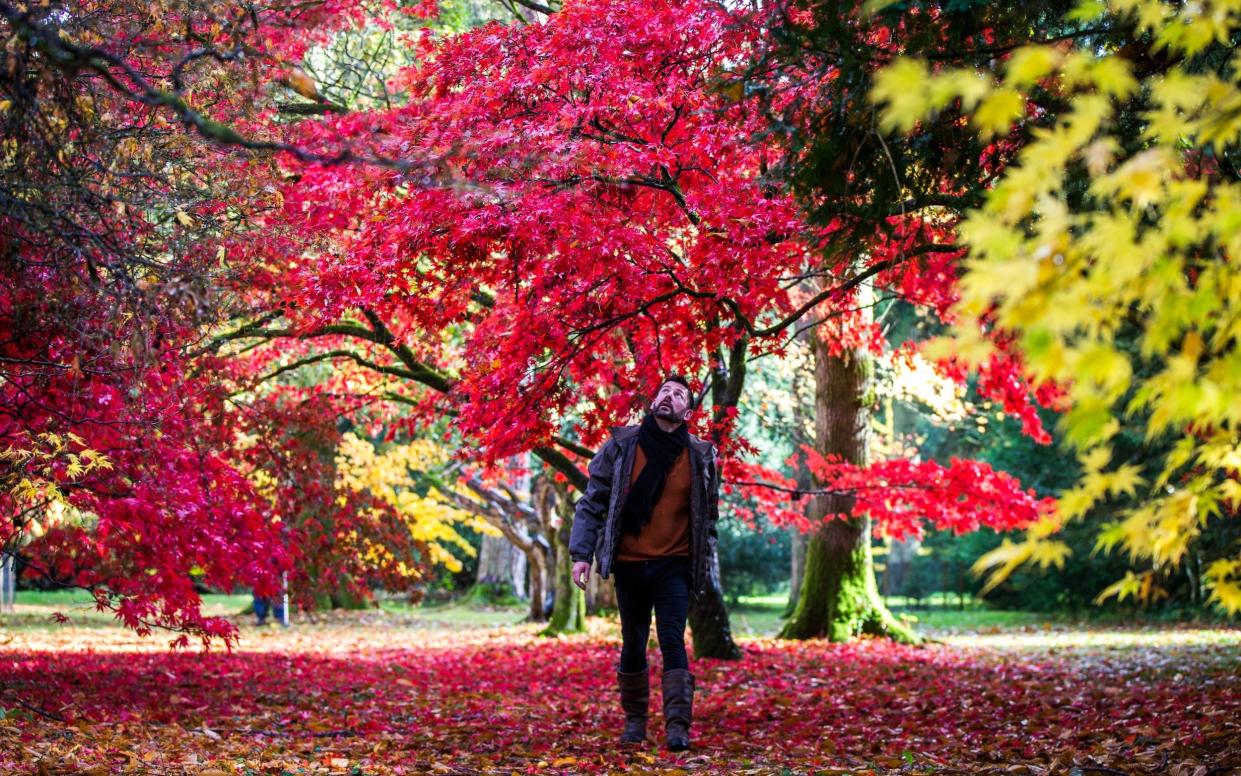
If you’re hoping to catch the blazing colours of autumn, your best bet is to head to your nearest arboretum. I was lucky enough to grow up a stone’s throw from Westonbirt, the National Arboretum in Gloucestershire, so my family and I visited regularly and never missed the spectacular display on show at this time of year.
My principal memory is the stuff of storybooks: kicking up a carpet of red, orange and yellow leaves as my sister and I raced through the Acer Glade in the Old Arboretum and Maple Loop in Silk Wood. As the arboretum holds the national collection of Japanese maples, which contains nearly 300 different types, I think it’s here that my father began his love affair with the species.

Fast-forward 40 years and we are still talking about acers in autumn, mostly, however, to try and persuade my father to move an Acer palmatum ‘Dissectum Atropurpureum’, which he planted in the middle of the lawn several years ago. The theory behind his decision was sound – a specimen tree can create a focal point and add year-round interest to a garden – but this one is clearly the wrong tree in the wrong place.
Sure, it provides welcome shade in summer for the family’s four-legged friends, and it really is a sight to behold as its leaves change colour, but this particular Japanese maple has a compact, weeping habit, which means that planted on its own, it looks for all the world as if Cousin Itt from The Addams Family is paying a visit.

If you are looking for a small specimen to grow in a container or as part of a border in a tiny garden, acers are a great choice. However, after many heated discussions at my parents’ house, these days I am inclined to play it safe and look beyond this popular genus to provide a splash of autumn colour in my garden. After all, I can always visit Westonbirt if I need a quick fix.
Here is my pick of favourite perennials, shrubs and trees that will put on a colourful show to rival that of the mostly graceful – though at times, slightly quirky – acer.
Perennials & grasses
Aster
Available in a range of shades – from white to pinks, purples and blues – these cottage-style perennials flower from late summer to October, which means they are ideal to plant in containers and borders for a splash of colour when much of the garden is fading. Loved by bees and butterflies, they also look gorgeous nestled next to ornamental grasses in prairie-style planting.

Preferring well-drained soil, they cope in either sunny or partially shady spots. Deadhead regularly to encourage blooms and cut back after flowering.
Powdery mildew can be an issue with some varieties, so keep the soil moist to prevent infection, or go for European varieties, such as Aster pyrenaeus ‘Lutetia’ and A x frikartii ‘Mönch’ which are resistant to it. Take softwood cuttings between April and August, or divide established clumps.
Note that some asters were recently reclassified, so popular New England types A. novae-angliae and A. novi-belgii, are now Symphyotrichum novae-angliae and Symphyotrichum novi-belgii. Plant in early spring to enjoy bright blooms in the first season.
Chrysanthemum
Blooms appear in late September and October – even November if you go for tender late varieties that will need to be grown under glass. There’s a range of shapes and shades, so it’s easy to find a chrysanthemum to suit your style and colour scheme.
For time-pressed growers, choose hardy varieties that won’t need to be dug up once they’ve finished flowering and stored for replanting when the risk of frosts has passed. They need moist but well-draining soil and it’s a good idea to add well-rotted manure at planting time, as well as a stake to ensure stems don’t break.
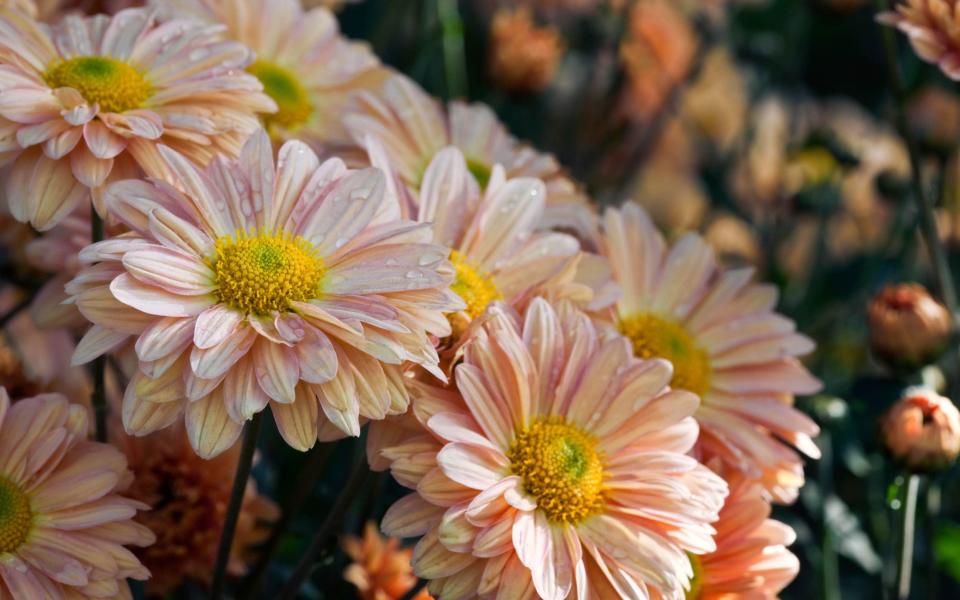
Pinch out tips when they’re about 20cm tall to encourage strong, floriferous plants, but if you want fewer, larger flowers, create a single stem by removing buds as they appear. Take basal stem cuttings in spring to bulk up stocks of your favourite types.
Keep an eye out for white rust, particularly during wet autumns, removing infected leaves. Pot-up rooted cuttings in early spring, ready to plant them out when the risk of frost has passed around mid-May.
Miscanthus sinensis
‘Malepartus’

It should be a good year for miscanthus, as the deciduous grass produces its best flowers after a long, hot summer. This variety is especially striking, with arching leaves that feature a distinctive central white stripe and take on a beautiful orange and red hue in autumn.
Miscanthus likes a sunny spot with well-draining soil, and doesn’t need watering or feeding to thrive. Cut back dead leaves in spring, once new growth starts, and bulk up stocks by dividing mature clumps in spring. Ideally plant in spring to provide enough time for this grass to get established.
Panicum virgatum
‘Shenandoah’
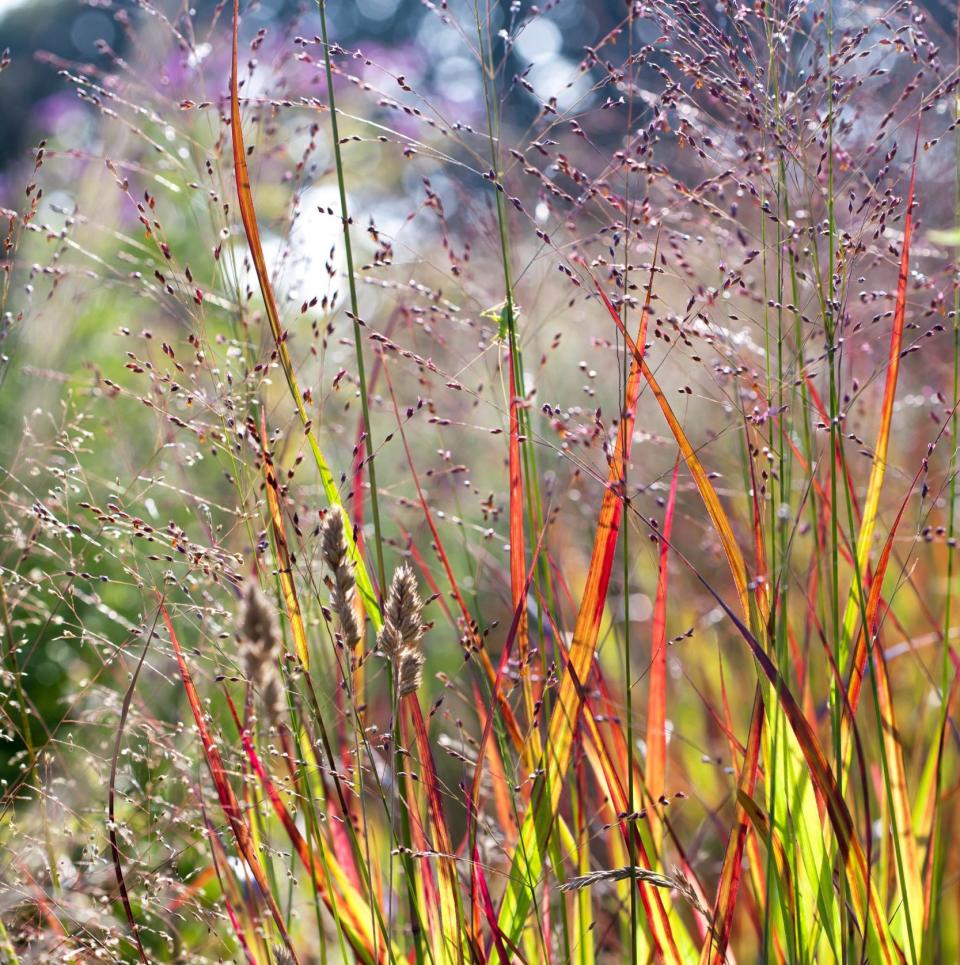
This switch grass looks like its tips have been dipped in colour, as the upright leaves turn from green to red-purple in autumn with a haze of purple-green spikelets adding further interest for gravel gardens, prairie-stye borders and patio containers.
Ensure it has a sunny spot and well-drained soil and cut back after flowering to encourage new growth. At 90cm tall, it’s more compact than other switches – for an extra 10cm, try ‘Purple Haze’ or ‘Heiliger Hain’.
Shrubs
Shrubs and trees are best planted in autumn and winter, giving them time to put down roots so they’re ready to cope with warmer weather. That said, avoid planting in very wet conditions or if there has been a frost and the ground is hard.
All varieties mentioned here will introduce a splash of autumn colour in the first year, but you’ll have to wait a couple of years for more impressive displays.
Callicarpa bodinieri var giraldi
‘Profusion’
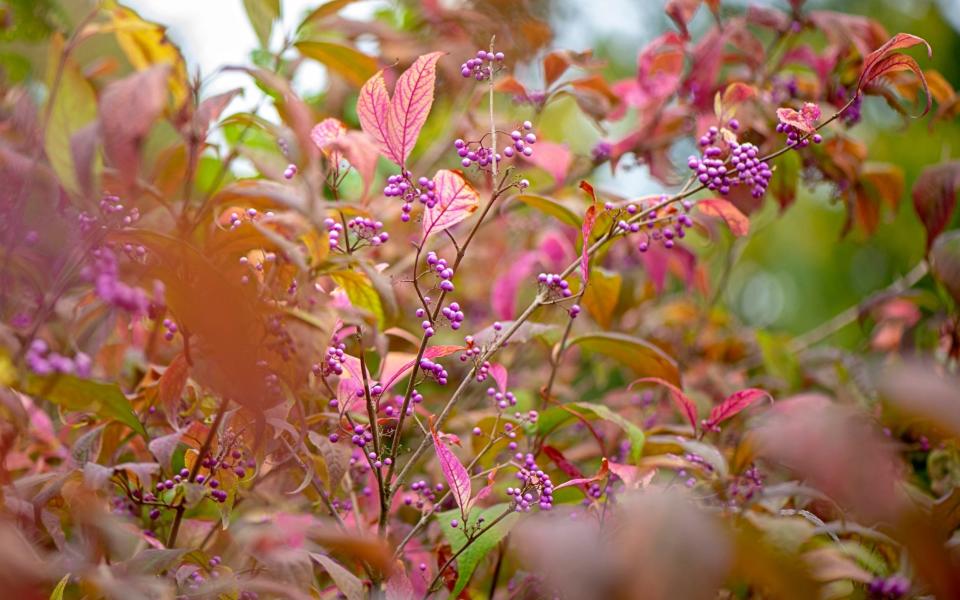
This medium-sized, deciduous shrub answers the brief when it comes to producing autumn colour, as clusters of metallic-violet berries remain on its branches long after it has dropped its leaves.
Though it may be a little on the gaudy side for some, don’t dismiss it too quickly because it is easy to care for. It’s also a useful addition to a cut-flower garden. If you have the space, pop it in a sunny border, in well-drained soil, and embrace the colour.
Euonymus alatus

Otherwise known as the burning bush, this deciduous shrub produces the most vivid scarlet leaves in the autumn, along with reddish-purple fruits, which split open to reveal orange seed capsules. Try growing it in a front garden or near the kitchen door, where you can really appreciate the display.
Make sure it has a sunny spot and moist, well-draining soil to produce the best displays. It is easy to care for: prune out damaged, dead or crossing branches in late winter and mulch annually with well-rotted manure or compost.
Hydrangea quercifolia

The dark green, oak-shaped leaves of this lovely shrub mature to shades of bronze, orange and reddish-purple in autumn. It also produces beautiful flowers that fade to pale pink and a delicate brown. Leave the ethereal, sculptural blooms on the shrub over winter as they add a bit of interest to the garden. Happy growing in either full sun or partial shade, Hydrangea quercifolia needs moist but well-draining soil.
Trees
Cercis canadensis
‘Forest Pansy’

The Cercis canadensis ‘Forest Pansy’, or Eastern Redbud, produces pretty heart-shaped leaves with pointed tips, which turn striking shades of orange, red, yellow and purple in autumn. Often grown as a multi-stemmed tree, it looks striking in beds and borders against contrasting foliage.
To get the best leaf colour, make sure it has plenty of sun and, ideally, moist but well-draining soil. It’s also a good idea to mulch with plenty of organic matter in the autumn or spring. It requires little else in the way of upkeep: prune in winter to remove damaged or unhealthy branches – and if you share your garden with rabbits, protect it with a guard.
Rhus typhina
A super specimen tree, the Stag’s Horn Sumach is often grown for its distinctively finely-cut dark green leaves, which produce a fiery display of orange-red tones in autumn; the cone-shaped dark red fruits of the female plants are also eye-catching at this time of year.

Culinary horticulturists take note: the fruit can be dried and used as an alternative to citrus-flavoured spice sumac, but ensure it’s Rhus typhina and not R. Verniciflua, which is toxic.
It likes moist but well-drained soil and plenty of sun, and it is worth surrounding the tree’s roots with a non-perishable barrier as it spreads by producing suckers.
Sorbus
Whether you’re growing our native rowan, or US or Japanese varieties, you can rely on these pretty specimens to produce dramatic displays of russet-red leaves in the autumn, along with bunches of red, yellow and orange fruit.
They’re all super choices for a small garden, where they will cope in full sun or partial shade and prefer moist but well-drained soil. They also need little pruning, unless branches are diseased or damaged, in which case remove them in late winter or early spring.
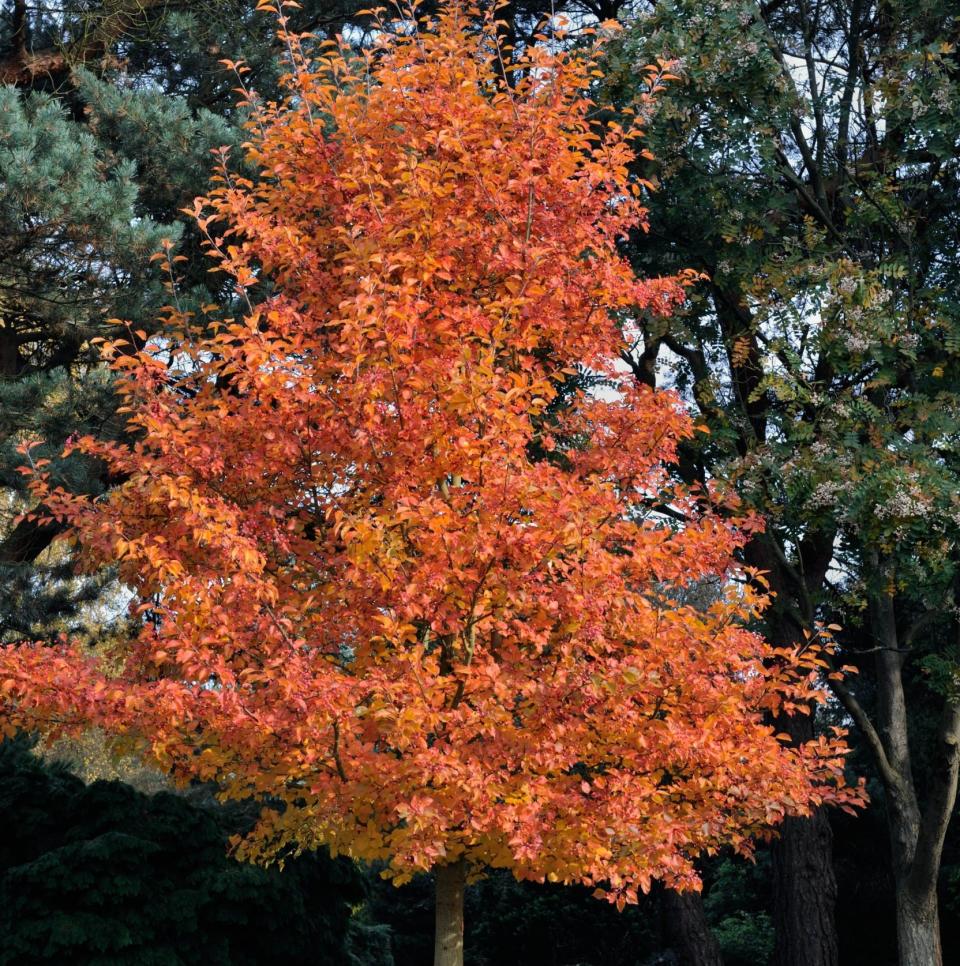
Can we expect spectacular displays of autumn colour this year?
Though many leaves have already turned yellow and dropped as a result of the prolonged dry weather, vibrant autumn hues on remaining leaves later in the season are still likely to show with favourable weather conditions in October.
As Andrew Smith, director of Forestry England’s National Arboretum at Westonbirt in Gloucestershire, explains: “If we experience some spells of rain in the coming weeks and continue to experience above average temperatures, the conditions would be right for maintaining sugar levels. This means that the leaves will stay attached to trees for longer and will have time to develop their autumnal shades.
"The length of display relies heavily on the weather throughout autumn. If it is mild, the leaves will have time for the build-up of chlorophyll to entirely fade and their dormant pigments to fully take over. I like to think of autumn as a firework display that rolls on with different colours appearing over several weeks. Climate change means that display is now being extended by days and weeks.”
Useful kit
Whether you are planning to grow your colourful displays in containers or garden borders, you need the correct tools for the job...

Clockwise from top left: Spade, Bulldog 28-inch treaded tree planting spear, £50.71; Tree guards, Grow Green biodegradable tree guard, from 93p each; Gloves, Donkey gardening gloves, £16; Secateurs, Niwaki GR Pro Secateurs, £84; Mulch mat, Haxnicks biodegradable coco fibre tree liners, £5.45 for a pack of three; Planters, Cube-shaped corten steel pots, from £80; Soil improver, Carbon Gold biochar tree soil improver, from £9.99 for 1 litre

 Yahoo Movies
Yahoo Movies 
